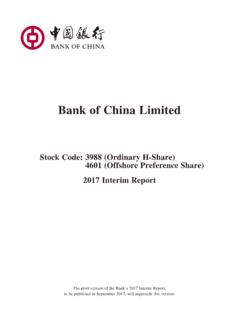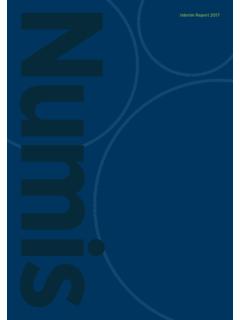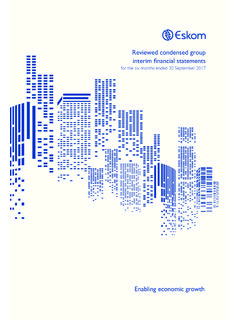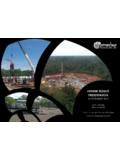Transcription of 2017 Big Four Inspections Report - CPAB CCRC
1 WORLD-CLASS AUDIT REGULATIONN ovember Big four Inspections ReportABOUT CPABThe Canadian Public Accountability Board (CPAB) is Canada s audit regulator responsible for the oversight of public accounting firms that audit Canadian reporting issuers. Through its annual Inspections program, stakeholder engagement initiatives and outreach to audit committees, and thought leadership activity, CPAB contributes to public confidence in the integrity of financial reporting, which supports effective capital markets. CPAB Report on 2017 Inspections of Canada s four largest public accounting firms CPAB s 2017 Big four Inspections Report provides an overview of the annual Inspections findings for Canada s four largest public accounting firms (Deloitte LLP, EY LLP, KPMG LLP, PwC LLP). These firms, and their foreign affiliates, audit approximately 98 per cent of all Canadian reporting issuers by market capitalization.
2 Each audit firm shares its file-level significant inspection findings (deficiencies in the application of generally accepted auditing standards that could result in a restatement of the company s financials), and this Report , with their clients audit committees. This Report includes common inspection finding themes and questions for audit committees to consider in conducting their oversight responsibilities. CPAB encourages all audit committees to discuss this Report , and any file-level findings, with their audit Of DIRECTORSCPAB has an 11-member Board of to public confidence in the integrity of financial reporting of public companies in Canada by effective regulation and by promoting quality, independent auditing. MISSIONE ffective regulation: Proactively identify current and emerging risks to the integrity of financial reporting of public companies in Canada by assessing how auditors effectively respond to those risks, and engage those charged with governance, regulators, and standard setters to develop sustainable operates from offices in Montreal, Toronto and employs approximately 50 professionals.
3 CANADIAN PUBLIC ACCOUNTABILITY BOARDSIGNIFICANT inspection FINDINGS LOWER IN 2017 ; CPAB VIEWS LONGER TERM CONSISTENCY THROUGH A QUALITY SYSTEMS LENS CPAB had fewer inspection findings across Canada s largest public accounting firms in 2017 compared to 2016 and 2015. We inspected 86 (2016:87) audit engagement files six of those files had significant findings compared to 11 files in 2016 and 24 files out of 93 in 2015. There are two restatements to date. While each Big four firm demonstrated an acceptable level of inspection findings overall, CPAB continued to find exceptions where they did not execute consistently across the firm. The need to fully embed audit approach improvements into every practice and every engagement still requires more attention. 26 Files withsignificantfindings 2 017 High quality, sustainable audits Firms have sound audit methodologies and in most cases we see compliant execution.
4 However, recurring inspection findings indicate the need to manage audit quality through robust and effective quality processes, embedding quality along the full audit cycle, not just assessing it at the end through internal and external Inspections . The variability of results, combined with persistent deficiencies in the areas of audit fundamentals, significant accounting estimates and professional judgment and skepticism (see 2017 Inspections Themes on page 5) year over year, makes it clear the firms need to continue to develop and strengthen their approach to audit quality and enhance their focus on consistent audit Findings: Six Year Trend2012 2013 2014 2015 2016 2017302520151050% files with significant findingsYear **Other Findings A noted deficiency in the application of generally accepted auditing standards related to a material balance sheet item or transaction stream where CPAB is able to conclude, without the engagement team performing additional procedures to support the audit opinion, that the deficiency is unlikely to result in a material misstatement.
5 These findings, while not significant, indicate areas for s risk-based methodology for choosing files to inspect is not intended to select a representative sample of the firm s audit work. inspection results should not be extrapolated across the entire population.*Significant Findings A significant inspection finding is defined as a deficiency in the application of generally accepted auditing standards that could result in a restatement. CPAB requires firms to carry out additional audit procedures to verify there was no need to restate the financialstatements due to material error, or to substantiate that they had obtained sufficient and appropriate audit evidence with respect to a material balance sheet item or transaction stream to support their audit opinion.**# Files with Significant Findings # Files with Other Findings # Files with No Findings2017 Big four Inspections Results: Engagement File Findings 201720153631452411633453520162 017engagement filesCPAB inspected86 ANNUAL Inspections Report MARCH 2016 BIG four Inspections Report NOVEMBER 2017 Firm focus: Building and embedding quality systems and processes In 2011, CPAB required the Big four firms to develop and implement action plans to address our most significant areas of concern and consistently enhance overall audit quality.
6 For the most part, these action plans have resulted in measurable improvements across all four firms. Since then, we have continued to ask the firms to update their action plans based on our annual findings, complete procedures to identify if restatements are required, evaluate the underlying causes of our findings, and update and revise tools and internal training as appropriate, among other things. Specifically in 2016, we required firms to focus on revising their guidance and methodologies to address systemic issues, identify and measure key quality controls and ensure issue escalation processes effectively manage and mitigate risk. Progress in these areas was made over the past 2017 we are asking the firms to identify and articulate their key quality risks and the processes and controls they have in place (actual workflow and monitoring that workflow) to support high quality audits so we can better understand what steps might be missing, potentially contributing to continued significant findings.
7 Until now, CPAB s Inspections have been heavily based on individual audit file reviews, with some attention to firm level quality systems and processes. To better identify and understand impediments to improving firm quality systems and consistency in how audits are performed, we plan to evolve our inspection approach in 2018 to incorporate additional operational reviews of the effectiveness of firm structure, accountabilities, quality processes, and culture. We believe that strong control processes and procedures at both the firm and engagement level will be fundamental to achieving further ongoing improvements in overall audit focus: Evaluating quality processes to assess overall audit quality and consistency an evolution in our inspection strategy Higher quality, consistently executed audits across a firm is achievable when the right people, policies and procedures are in place in other words, how well firms manage their talent by matching capabilities to client and audit risk and ensuring appropriate resources are in the right place at the right time.
8 From that perspective, in 2016 we explored what CPAB and the firms might do differently to advance improvements in audit quality (see box for quality definition). 3 CANADIAN PUBLIC ACCOUNTABILITY BOARDQ uality can be defined as a degree of excellence or in the context of an audit, compliance with professional standards as set out in the Canadian Auditing Standards including the Canadian Standard on Quality Control (CSQC 1) quality control for firms that perform audits and reviews of financial statements, and other assurance engagements. At the client engagement level, this translates to an auditor obtaining sufficient and appropriate audit evidence to support the opinion that the audited financial statements are free from material misstatement. At the firm level, this translates to a firm having quality systems and processes enabling engagement teams to consistently obtain sufficient and appropriate audit evidence for each and every audit engagement of the firm.
9 The measure of audit quality at the client engagement level is relatively straightforward and is determined based on the number and severity of inspection findings in the file under assessment of a firm s audit quality is more challenging. Its measure is a combination of a firm s file inspection results along with an assessment of the effectiveness of the firm s quality processes designed to support engagement teams and ensure consistency in audit execution as measured by a reduction in significant inspection findings to an acceptably low Audit Quality4At the engagement level, a number of files will be specifically selected to validate our findings on firm quality processes. We will also continue to conduct risk-based file Inspections . Through our evaluation of a firm s quality processes (as evidenced by our file inspection results) CPAB will be able to better assess a firm s overall audit revised methodology will concentrate on five criteria related to key functions we believe enable audit quality through consistent execution, including proactive audit issue identification and escalation mechanisms for issues resolution.
10 The first four criteria (Accountability for Audit Quality, Firm Talent Management, Firm Risk Management, Firm Resource Management) are processes and procedures we expect to occur at the firm level in support of individual engagement teams. Oversight is the fifth criterion and focuses on the firm s oversight of the engagement team s interaction with the client and comprises the Audit Process and Client Process. Here we will focus on the firm s leadership ability to proactively monitor engagement level activity and the effectiveness of issue identification, escalation and intervention plan to launch this new approach in March 2018 at the Big four firms. We ll run a limited number of pilots in the fall of 2017 . Going forward, we expect to apply the new model to the 10 other annually inspected firms in 2019 or beyond.







